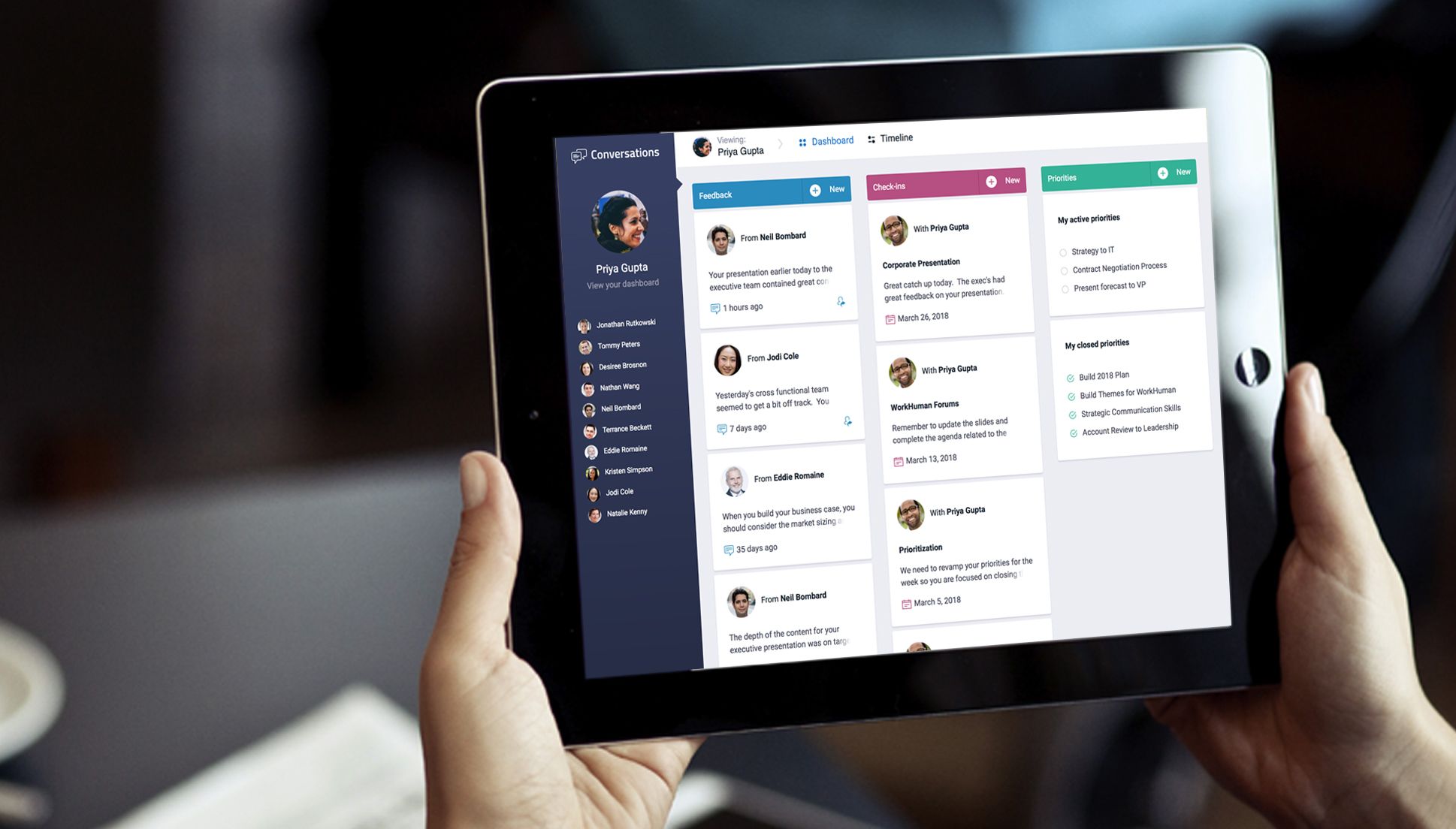Traditional performance management systems and processes have limited or even negative impact, and more and more companies are moving away from solely relying upon the annual review to share feedback and insight on performance with their employees. Performance management is no longer just an electronic record or piece of paper with a rating; it’s an everyday conversation – a series of continual connections between the managers and employees that work together in your organization. The most competitive companies embrace this ideal; the least competitive companies cling to top-down, slow-moving hierarchical data collection processes focused more on the management of performance than creating a culture of performance. The time is now to reinvent continuous performance management, and humans are at the heart of this.
Annual raises and lump-sum bonus payments have proven ineffective at driving performance improvements, with any lift in engagement or performance lasting only 3-4 weeks, according to a Workhuman study. An even bigger impetus to change is employees’ growing discontentment with the current process and their desire for more frequent, timely feedback and ongoing conversations about their work and their contribution to the company.
Forward-thinking companies understand the true potential of performance management, which cannot be achieved by a once-a-year appraisal and a rating created from the top down. By shifting traditional performance management to continuous performance management—built on a foundation of regular check-ins, ongoing feedback, and frequent recognition moments—companies can optimize performance by enabling employees to achieve more with the support of their peers and manager.
Here are six strategies for reinventing your organization’s performance management.
Build a foundation of trust through a culture of authenticity and positivity.
Trust is at the heart of effective performance management. Building trust requires cultivating a culture of authenticity and positivity, where employees feel safe giving, receiving, and asking for feedback from colleagues or managers.
Joe Hirsch, TEDx and keynote speaker, Inc. columnist, and author of The Feedback Fix, believes that creating this sense of psychological safety around feedback is essential. “Most people fear feedback because it operates in the realm of judgment,” he says. “If you create a new mindset toward feedback that’s focused on development and growth, then you give people permission to be more open and honest about the challenges they’re facing. You also increase the odds that they will receive your feedback more favorably, because they know that it’s coming from a place of honesty, trust, and encouragement rather than one of judgment and retribution.”
While everyone has a role to play in developing this foundation of trust and inclusivity, leaders have a unique opportunity to create the conditions for success and model the behaviors that promote a human-centric performance feedback culture. “As a leader, I will model what it means to be vulnerable by asking my team for feedback about my work,” Hirsch says. “It changes the dynamics from hierarchy to partnership, from prescription to description. And those dynamics make a world of difference in how feedback is felt [experienced] and, ultimately, acted upon. Feedback and check-ins become positive, productive, and energizing interactions that employees look forward to, rather than being sources of anxiety and stress.”
Encourage employees to participate actively in their own success.
Equipping employees with tools and technologies that allow, or even encourage, them to engage proactively in frequent conversations about their real-time work and priorities empowers them to own their growth and development.
Setting operational and developmental goals with their managers that align with strategic business objectives and shared purpose helps employees understand how integral they are to the team’s success and feel more connected to their career path. It also gives them a greater sense of meaning in their work, which has a huge impact on their overall employee experience, according to a study from IBM.
Embrace the 3 C’s: continuous, crowdsourced, and culturally aligned.
A fundamental flaw of the traditional performance management process is that feedback is rarely, if ever, given outside the context of an annual performance review. According to PwC, 60% of employees (and 72% of millennial employees) would like to receive feedback daily or weekly, and an Adobe study revealed that 80% of office workers want immediate, in-the-moment feedback.
In a modern, human-centric work culture, performance discussions occur frequently, in real-time, and are enhanced by input and data from the crowd. Appreciation and recognition (which are forms of positive feedback) are given in a timely manner, creating meaningful moments of connection that can have a lasting, positive impact on the recipient. It is suggested that same timeliness and approach should be true with all feedback, including constructive, instructional, developmental and growth-focused feedback.
Goal setting for employees should also be closely aligned with the organization’s cultural norms, behaviors, and core values to provide employees with a strong sense of purpose. Implementing a continuous performance management approach without this alignment will leave the employees unclear on the larger organizational vision and the impact of their work.
Approach as a coach.
Managers should be encouraged to view their primary role as coaching employees to consistently improve their performance over time and encourage their direct reports to seek feedback from multiple sources to alleviate the concern that feedback is only coming from one voice, with one opinion and limited vantagepoint.
Hirsch believes managers should approach conversations with two goals in mind: greater humility and greater curiosity. “Be a learn-it-all, not a know-it-all. Assume the person closest to the action may know things you don’t, and also may have a better understanding of what might need to happen next.”
Co-workers – those people in the ecosystem who truly see where, when, and how work gets done – provide a wider, deeper insight into employees’ work that the manager doesn’t always have.
Make weekly check-ins a top priority to promote continual learning, improve retention, and foster human connections.
The ideal moment for feedback is in real-time as the behavior occurs, not days, weeks or months later, so managers and employees have the benefit of addressing performance concerns immediately.
Younger employees want goals to be clearly defined up front, followed by regular check-ins and ongoing feedback that is fresh in the manager’s and employee’s minds, so the learning is timely and relevant. Check-ins are a quick and easy way to keep track of tactical updates and developmental discussions between managers and employees. Having these open and honest conversations in real-time, on a regular basis, builds human connections and relationships founded in trust, allowing for course corrections as needed.
Shift from high-stakes, low-frequency feedback to low-stakes, high-frequency conversations.
Annual performance reviews and ratings often affect decisions about employees’ income, advancement, and continued employment. These high stakes create stress and anxiety for both managers and employees. For many employees, the formal, once-a-year performance review is the only time they receive feedback, and they may feel blindsided on discovering an issue with their performance months later, when it’s too late for them to remediate it by receiving the necessary coaching.
Continuous performance management takes the opposite approach: ongoing, frequent, conversations, sometimes planned and other times occurring more organically within the flow of work. Hirsch recommends that managers create, and look for, opportunities to have these types of informal conversations as often as possible. “The really high-performing organizations are the ones that are having these conversations so often that people don’t even think about them; they become as normal and natural as breathing, blinking, or getting a cup of coffee.”







